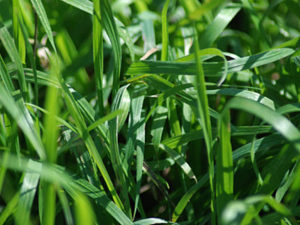The role of macronutrients and micronutrients in turf nutrition
While nitrogen (N), phosphorous (P) and potassium (K) tend to get all the attention when it comes to turf nutrition, there are fourteen other nutrients that play important roles as well. These include carbon, hydrogen, oxygen, calcium, magnesium, sulfur, iron, manganese, zinc, copper, boron, molybdenum, chlorine and nickel. When the soil cannot supply adequate amounts of these nutrients, supplemental fertilizer applications may become necessary.
A Closer Look at the Essential Nutrients
Non-mineral Nutrients
 Turf pulls large amounts of carbon, hydrogen and oxygen from the atmosphere in the form of carbon dioxide (CO2), oxygen (O2) and water (H2O). These non-mineral nutrients are considered to be “the building blocks for plant growth,” says University of Illinois Extension Specialist David Robson. The remaining 14 mineral nutrients are derived from the soil.
Turf pulls large amounts of carbon, hydrogen and oxygen from the atmosphere in the form of carbon dioxide (CO2), oxygen (O2) and water (H2O). These non-mineral nutrients are considered to be “the building blocks for plant growth,” says University of Illinois Extension Specialist David Robson. The remaining 14 mineral nutrients are derived from the soil.
Primary Macronutrients
Nitrogen (N) is vital for the production of chlorophyll, turf’s green pigment. Plants deficient in nitrogen have light green to yellow leaves and appear stunted. Because plants perform best with consistent supplies of nitrogen, controlled-release fertilizers (CRFs) have become a popular choice for turfgrass applications.
Phosphorus (P) promotes root formation and growth. When compared to nitrogen and potassium, phosphorous is used in relatively small amounts.
Potassium (K) helps turf overcome drought stress and improves winter hardiness and drought tolerance.
Secondary Macronutrients
Calcium (Ca) is important for the healthy development of plant shoots and roots. Calcium deficiencies are rare when turf growers maintain the correct soil pH for their specific species and region. “In the rare event when calcium is recommended for a lawn with an adequate pH, growers can use gypsum as a calcium source,” recommends Peter Landschoot, professor of turfgrass science at Pennsylvania State University.
Magnesium (Mg) is a component of chlorophyll. Deficiencies result in yellowing leaves or foliar chlorosis.
Sulfur (S) is sometimes used to lower soil pH in cases where high pH levels are problematic, Landschoot explains, adding that this macronutrient is usually only necessary in western U.S. states where arid conditions can lead to alkaline soils.
Micronutrients
“Micronutrients are needed by turfgrasses only in minute amounts and rarely need to be supplied to turfgrasses growing in mineral soils,” Landschoot says. “However, when turfgrasses are grown in high-sand-content soils or high-pH soils, micronutrient applications can be beneficial.”
Iron (Fe) is important in chlorophyll formation and photosynthesis. Deficiencies result in chlorosis of young leaves. According to Landschoot, iron fertilizer is applied to enhance turf color without stimulating excessive leaf growth.
Boron (B) plays a role in DNA synthesis and translocation of sugars, but it can be toxic, even when applied in small amounts.
Zinc (Zn) is involved with the enzyme systems that regulate metabolic activity.
Copper (Cu) is a component of various plant enzymes, but “indiscriminate use of copper can lead to iron deficiencies in turfgrasses,” Landschoot says.
Manganese (Mn) in excess can reduce plant growth or produce brown spots, while plants lacking Mn may have gray or tan spots.
Plants deficient in molybdenum (Mo) may have twisted leaves and marginal scorching.
Chlorine (Cl) deficiencies result in wilted leaves that become bronze, then chlorotic, and then necrotic. Excess chlorine can cause salt injury and leaf burn.
Nickel (Ni) and cobalt (Co) are recently established essential plant nutrients. Nickel can encourage seed development and cobalt is important for nitrogen fixation.
KeyPlex offers a wide range of products for plant nutrition programs. TurfPlex is a combination of secondary macronutrients and micronutrients designed specifically for use on turfgrass. The blend contains alpha-keto acids, which may facilitate utilization of micronutrients, and increase resistance to environmental stresses.
